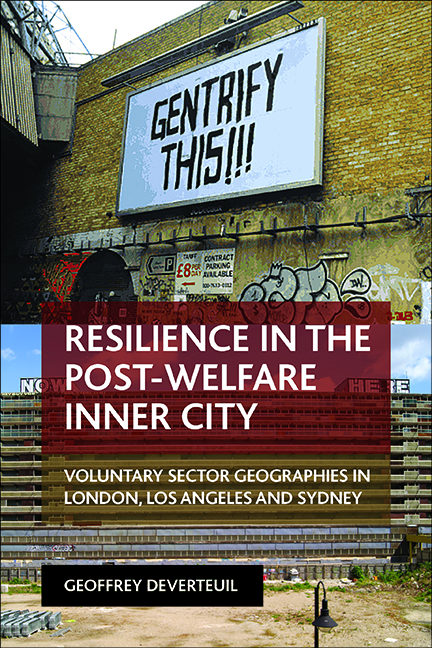 Resilience in the Post-Welfare Inner City
Resilience in the Post-Welfare Inner City Book contents
- Frontmatter
- Dedication
- Contents
- List of tables and figures
- About the author
- Acknowledgements
- Preface
- Part One Introducing resilience in the post-welfare inner city: conceptual and methodological considerations
- Part Two Case studies: spatial and social resilience in London, Los Angeles and Sydney
- Part Three Conclusions, critical resilience, commons and austerity
- References
- Index
ten - Comparative analysis and summary
Published online by Cambridge University Press: 10 March 2022
- Frontmatter
- Dedication
- Contents
- List of tables and figures
- About the author
- Acknowledgements
- Preface
- Part One Introducing resilience in the post-welfare inner city: conceptual and methodological considerations
- Part Two Case studies: spatial and social resilience in London, Los Angeles and Sydney
- Part Three Conclusions, critical resilience, commons and austerity
- References
- Index
Summary
In Chapter Five, I began the comparative analysis by placing inner-city London, Los Angeles and Sydney side by side. In this chapter, I analyse similarities and differences in voluntary-sector resilience (spatial and social) across the 100 organisations embedded within four place-types and three global city-regions, using the three hallmarks of my comparative approach in Chapter Four, while suggesting lines of research for comparative resilience. As a starting point, and emerging organically from the results from Chapters Five to Nine, I propose three prevailing strategies of spatial resilience. These strategies built on and somewhat reworked literatures on (1) the barriers to gentrification (Shaw, 2005; Ley & Dobson, 2008; Walks & August, 2008) and, more specifically, (2) the geographies of anti-displacement, based primarily on the work of Newman and Wyly (2006: 28), who sought to explain why gentrified neighbourhoods in New York City do not always produce displacement – ‘that after two generations of intense gentrification, any low and moderate-income renters who have managed to avoid displacement are likely to be those people who have found ways to adapt and survive in an increasingly competitive housing market’. I have little interest here in overt residential resistance to gentrification (for example, Sakizlioglu & Uitermark, 2014) – rather, I privilege the active outflanking and persistent outlasting of gentrification via the production of institutionalised resilience.
For the first strategy of resilience – which I deem the ‘private’ – Newman and Wyly (2006) identified a variety of active residential strategies, such as overcrowding, enduring high housing costs and poor housing quality, and owner-occupation that consistently inhibited displacement. For voluntary-sector organisations, these private strategies can be translated into (1) owning your own building, or (2) leasing it from a supportive landlord that is not profit seeking. These became barriers to gentrification-induced displacement as they involved removing oneself from the vagaries of the private real estate market. Leasing from supportive landlords could include larger umbrella voluntary-sector organisations, as well as faith-based organisations, whose religious infrastructure can be remarkably central and accessible. As the coordinator of Housing Justice in London commented, “churches are not in the business of flipping real estate, they are in it for the long haul, so they act as a barrier to gentrification”.
- Type
- Chapter
- Information
- Resilience in the Post-Welfare Inner CityVoluntary Sector Geographies in London, Los Angeles and Sydney, pp. 199 - 216Publisher: Bristol University PressPrint publication year: 2015


